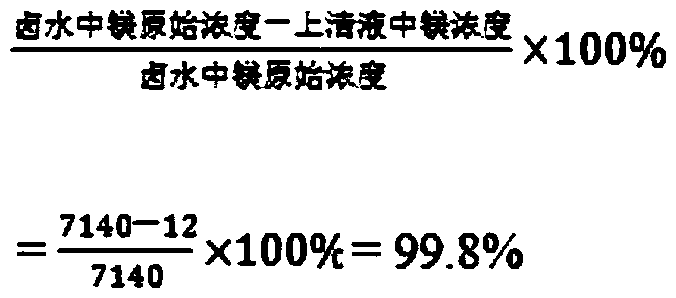Method for synthesizing multi-element sustained-release compound fertilizer by using magnesium in seawater or bittern water
A technology of slow-release compound fertilizer and salt brine, which is applied in the field of comprehensive resource utilization, can solve the problems of undiscovered multi-component slow-release compound fertilizer, and achieve good economic benefits, high recovery rate, and low cost of source materials
- Summary
- Abstract
- Description
- Claims
- Application Information
AI Technical Summary
Problems solved by technology
Method used
Image
Examples
Embodiment 1
[0046] Using magnesium in salt brine to synthesize multivariate slow-release compound fertilizer.
[0047] The brine was obtained from Haitian Company, Xiaying Economic Development Zone, Changyi City, Weifang City, Shandong Province, and its component contents are shown in Table 1.
[0048] Content of relevant components in table 1 salt brine
[0049] element
K
Na
Ca
Mg
P
N
Content, mg / L
275
43565
1491
7140
0.7
0.3
[0050] The inducer is: Potassium dihydrogen phosphate.
[0051] A. Preparation of diluent
[0052] First dissolve 3g of anionic polyacrylamide in 800ml of deionized water, stir for more than 2 hours, and fully dissolve; then add 117.0g of solid sodium hydroxide and 10.0g of powdered activated carbon, and use deionized water to make up the volume to a 1000ml volumetric flask.
[0053] B. Reaction synthesis of multivariate slow-release compound fertilizer
[0054] According to PO 4 3- :K + : Mg 2+ =...
Embodiment 2
[0063] The inducer is: potassium dihydrogen phosphate + potassium chloride.
[0064] The basic situation is the same as in Example 1, except that after adding potassium dihydrogen phosphate, 11g potassium chloride is added again, and the number of ions is adjusted to be PO 4 3- :K + : Mg 2+ =1:2:1.
[0065] Obtain multivariate slow-release compound fertilizer 32.7g, wherein Na3.1%, K9.3%, Mg10.2%, Ca2.2%, P 2 o 5 28.1%. Potassium content increased significantly.
[0066] The element K concentration in the supernatant was 9194mg / L, the Ca concentration was 521mg / L, Mg was not detected, and the P concentration was 433mg / L (based on PO 4 3- count).
Embodiment 3
[0068] The inducer is: potassium dihydrogen phosphate + potassium chloride.
[0069] The basic situation is the same as in Example 1, except that after adding potassium dihydrogen phosphate, 22g potassium chloride is added again, and the number of ions is adjusted to be PO 4 3- :K + : Mg 2+ =1:3:1.
[0070] Obtain 33.0 g of multivariate slow-release compound fertilizers, wherein the K content is 10.7%, and the contents of other components are similar to those in Example 2. Potassium levels are up a bit again.
PUM
 Login to View More
Login to View More Abstract
Description
Claims
Application Information
 Login to View More
Login to View More - R&D
- Intellectual Property
- Life Sciences
- Materials
- Tech Scout
- Unparalleled Data Quality
- Higher Quality Content
- 60% Fewer Hallucinations
Browse by: Latest US Patents, China's latest patents, Technical Efficacy Thesaurus, Application Domain, Technology Topic, Popular Technical Reports.
© 2025 PatSnap. All rights reserved.Legal|Privacy policy|Modern Slavery Act Transparency Statement|Sitemap|About US| Contact US: help@patsnap.com

